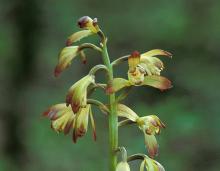Wildflowers, Grasses and Other Nonwoody Plants
Media

Species Types
Scientific Name
Lactuca floridana
Description
A true lettuce that can be eaten as a cooked or salad green, Florida lettuce has lavender to purplish blue flowers and grows statewide.
Media

Species Types
Scientific Name
Monotropa hypopitys
Description
Pinesap is a plant that puts the "wild" in wildflower! It lacks chlorophyll, so its roots connect to fungi underground and absorb nutrients from the fungi.
Media

Species Types
Scientific Name
Monotropa uniflora
Description
Indian pipe lacks chlorophyll, so it is white, not green. Below ground, its roots join with fungi that connect to tree roots. This plant, then, takes nourishment indirectly from the trees.
Media

Species Types
Scientific Name
Aplectrum hyemale
Description
Adam and Eve orchid is noticeable on winter woodland hikes. It is a green-and-white-striped, pleated leaf lying flat upon the dead leaves on the forest floor. Check back in May to see its flowers!
Media

Species Types
Scientific Name
Dioscorea oppositifolia (sometimes called D. batatas)
Description
Similar to kudzu, Chinese yam is an aggressive vine that overtakes nearly everything within reach that stands still long enough! Learn more about this invasive plant — and please don’t plant it!
Media

Species Types
Scientific Name
Asclepias incarnata
Description
Swamp milkweed has pink flower clusters at the tips of its tall stalks. The leaves are opposite, narrow, and up to 6 inches long. It grows in moist bottomland soils.
Media

Species Types
Scientific Name
Asclepias purpurascens
Description
The flowers of purple milkweed are pale purple to reddish purple to dark purple, with greenish or red tints. The scientific name means “becoming purple”: The flowers start off rather pale and become more intensely purplish as they mature.
Media

Species Types
Scientific Name
Silene stellata
Description
A member of the pink or carnation family, starry campion has fringed, white petals that give it a starry appearance. It blooms from June to September in dry, wooded uplands and slopes.
Media

Species Types
Scientific Name
Saponaria officinalis
Description
Soapwort is a tall, showy wildflower that has chemicals in its sap that lather up like soap. Native to Eurasia, it has been introduced worldwide and is a common roadside wildflower.
Media

Species Types
Scientific Name
Dianthus armeria
Description
Deptford pink has straight, strong, narrow stems that bear small clusters of pink flowers with white dots. Common statewide in sunny, open locations such as pastures and roadsides.
See Also
About Wildflowers, Grasses and Other Nonwoody Plants in Missouri
A very simple way of thinking about the green world is to divide the vascular plants into two groups: woody and nonwoody (or herbaceous). But this is an artificial division; many plant families include some species that are woody and some that are not. The diversity of nonwoody vascular plants is staggering! Think of all the ferns, grasses, sedges, lilies, peas, sunflowers, nightshades, milkweeds, mustards, mints, and mallows — weeds and wildflowers — and many more!





















